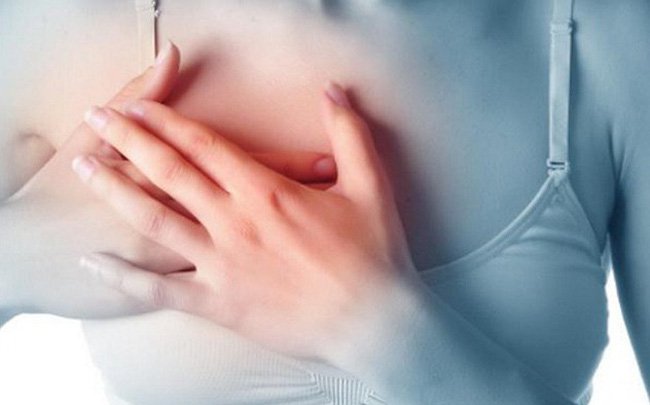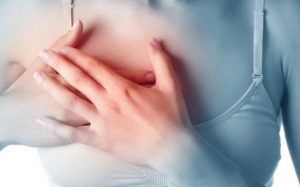
Breast cancer is the leading cause of death in women, so it is important to identify the symptoms of the disease and treat it promptly. Fully equip the knowledge about this disease by referring to the article below.
1. What is breast cancer?
Breast cancer is a malignant breast lump. A tumor can be benign (not cancerous) or malignant (cancerous). Most breast cancer cases begin in the milk ducts, a small portion develops in the milk pouch or lobe. If breast cancer, if detected and treated late, can spread to bones and other organs, the pain will increase.
2. Breast cancer warning signs
2.1 Chest pain
The chest area feels dull, there is no clear rule. It is probably an omen of early stage of malignant breast cancer. If your chest is sore, persistent or intense, you should seek medical attention immediately.

2.2 Change of skin area
Most people with this condition often change the nature of their chest skin color. The skin may look wrinkled or concave, just like dimples, the surrounding skin often has blisters and prolonged itching.
2.3 Swollen or swollen glands
Swollen lymph nodes are not only a sign of common illnesses such as influenza, infection, but also breast cancer. If a painful or swollen lump lasts for several days and you don’t know the cause, this could be a sign of breast cancer.
2.4 Pain in the back, shoulders or neck
Some women who have this disease instead of chest pain often experience back or neck pain. Pain usually occurs in the upper back or between the shoulder blades, which can be mistaken for ligament relaxation or diseases directly related to the spine.
Chest pain is a symptom of breast cancer.
3. Stages of breast cancer
Unlike other types of cancer, breast cancer is a completely treatable disease, if detected in its early stages, about 80% of patients will be completely cured if the disease is detected at an advanced stage. head.
3.1 Stage 0 breast cancer (early stage)
At this early stage, the doctor discovers breast cancer cells in the milk ducts. We call this non-invasive breast cancer, also known as local breast adenocarcinoma. Patients will be treated for breast cancer to prevent the spread of the disease. Usually the patient only needs to remove the tumor and use additional radiation therapy.
3.2 Stage 1 breast cancer
At stage 1A, the tumor is still small, 2 cm and the lymph nodes are not affected. As the disease progresses to stage 1B, not only breast tumors but also tumors will appear in the axillary lymph nodes. These are two additional stages of early detection. Your doctor will use a surgical procedure that combines several treatments to treat this condition.
3.3 Stage 2 breast cancer
In stage 2, the tumors are 2 to 5 cm in size and may not spread to the lymph nodes or armpits. This phase is divided into 2 phases: 2A and 2B.
- Stage 2A: there is no primary tumor and less than 4 lymph nodes. The tumor size is less than 2 cm and less than 4 lymph nodes. The tumor is 2 to 4 cm in size and does not spread to lymph nodes and lymph nodes under the arm.
- Stage 2B: At stage, the tumor is 2 to 4 cm in size and detects the accumulation of cancer cells in the lymph nodes, from 1 to 3 lymph nodes under the armpit or near the breastbone . Or the size of the tumor exceeds 5 cm and does not enter the lymph nodes.
Patients discovered at stage 2 must combine surgery, radiation, chemotherapy and hormone therapy.
3.4 Stage 3 breast cancer
When you have stage 3 disease, the tumors in the body spread from 4 to 9 axillary lymph nodes or swollen lymph nodes in the chest.
In step 3, treat the patient in a similar way to step 2. If the doctor detects a large primary tumor, you will need chemotherapy to shrink the tumor before continuing. surgery
Breast cancer stage 3.5 (terminal stage)
This stage is considered the final stage of cancer. Cancer cells spread and metastasized in many organs of the patient’s body. Breast cancer usually spreads to bones, brain, lungs and liver. At this point, your doctor will prescribe a full body treatment, which is common for patients on advanced breast cancer.
4. Causes of breast cancer
Breast cancer is often found in people who give birth late, cannot reproduce or not breastfeed.
Genetic: if a family has a mother or grandmother, siblings with the disease, you should also go to the hospital for a checkup, as the disease can be inherited by family members.
Early menstruation or late menopause can also cause disease.
People with a history of breast disease such as cystic fibrosis …
Living in a toxic and polluted environment also facilitates breast cancer.
Obesity, a sedentary lifestyle, low intake of vitamins, smoking and alcohol are also at risk of breast cancer.
5. Subjects at risk of breast cancer
People with a family history of breast cancer.
People who have fertility problems (infertility, infertility or first child over 35 years old) .гнн people who have a history of cysts or fibroids, ovarian cancer, uterine cancer …
People often exposed to chemicals
6. Treatment of breast cancer
Breast cancer surgery
For small tumors, the doctor will order removal surgery. If the cancer has spread, the doctor will perform mastectomy (this is a complete removal of the mammary glands, including the skin, nipples, and mammary glands).
Surgeons will perform a skin-saving emulsion that promotes reconstruction of the mammary gland and may also clear lymph nodes for a biopsy to analyze cells to detect cancer that has spread to the breast. lymph nodes. In some cases, women with breast cancer may choose to have a bypass surgery (also called a preventive mastectomy), if the risk is high, for example, a family history of people with breast cancer. or carry a gene associated with the mutation.
radiotherapy
This method uses high-energy rays, such as X-rays and protons, to destroy cancer cells. After the patient has a mastectomy, the rays will be used for external irradiation to ensure the cancer cells have been destroyed.
Valence
Use medicine to kill cancer cells. Subjects who have cancer cells are at risk of recurrence or spreading to other parts of the body. Sometimes chemotherapy is also given first to reduce a large tumor to be easily removed during surgery. Chemotherapy is usually indicated when the cancer has spread, the goal is to better control the accompanying symptoms.
7 How to prevent breast cancer
Eat more green vegetables, increase the amount of foods rich in phytoestrogens
Breast cancer screening and routine checkups. Since the preclinical stage of breast cancer lasts for 8 -10 years, screening is highly recommended in detecting and treating breast cancer. The disease is effective. If the disease is detected in stage 1, the cure rate can reach more than 80%, in stages 2 – 60% while maintaining the breast. At the third stage, the probability of recovery is certainly very small. In the fourth stage, treatment is only aimed at prolonging life and reducing pain.
Increase Best Knowledge about the disease to detect the first symptoms associated with the disease.
Build a healthy lifestyle:
- Eat lots of green vegetables, increase the amount of phytoestrogen-rich foods
- Consider hormone therapy during menopause: an increase in the amount of estrogen hormone in the body can increase breast cell division, increasing the risk of stimulating the growth of abnormal cells. often causes breast cancer.
- Pay attention to certain medications, such as antidepressants and diuretics, that increase the risk of breast cancer
- Source: Vinmec





